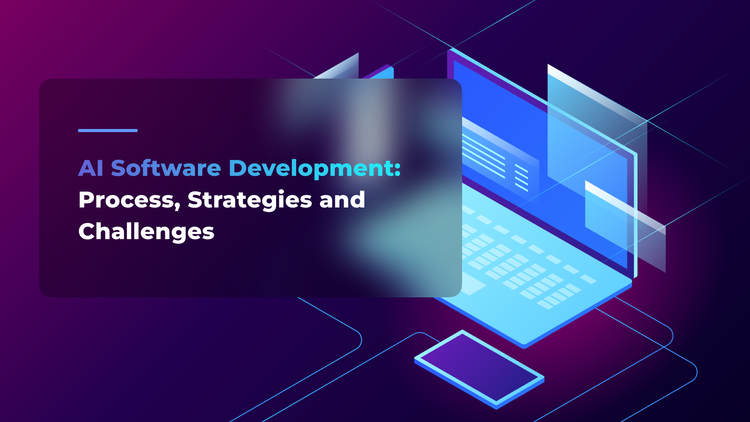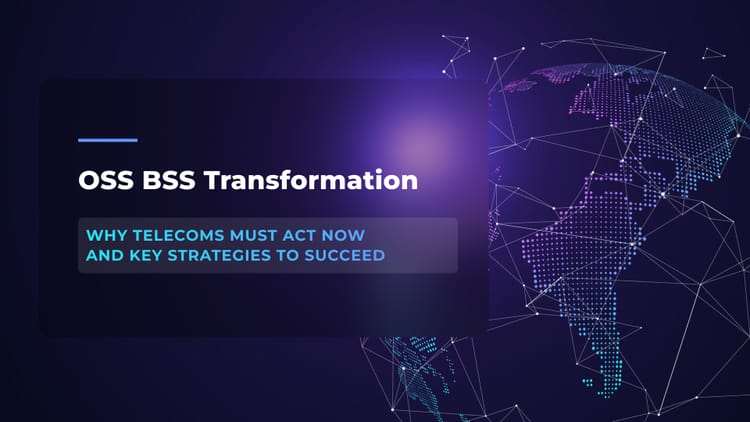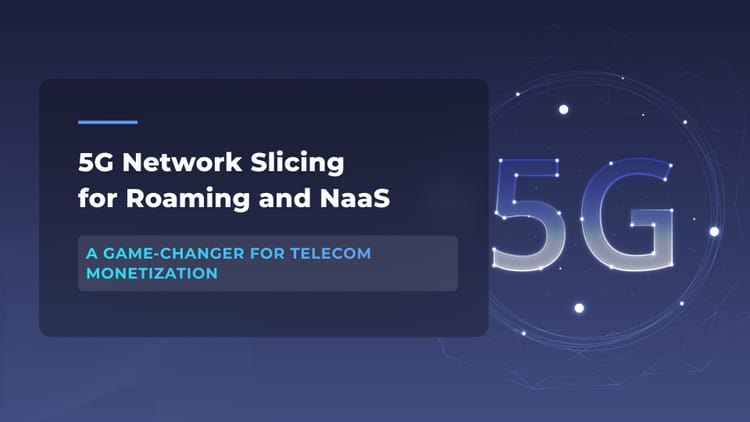Generative AI in Telecom: How to Leverage It for Business Growth
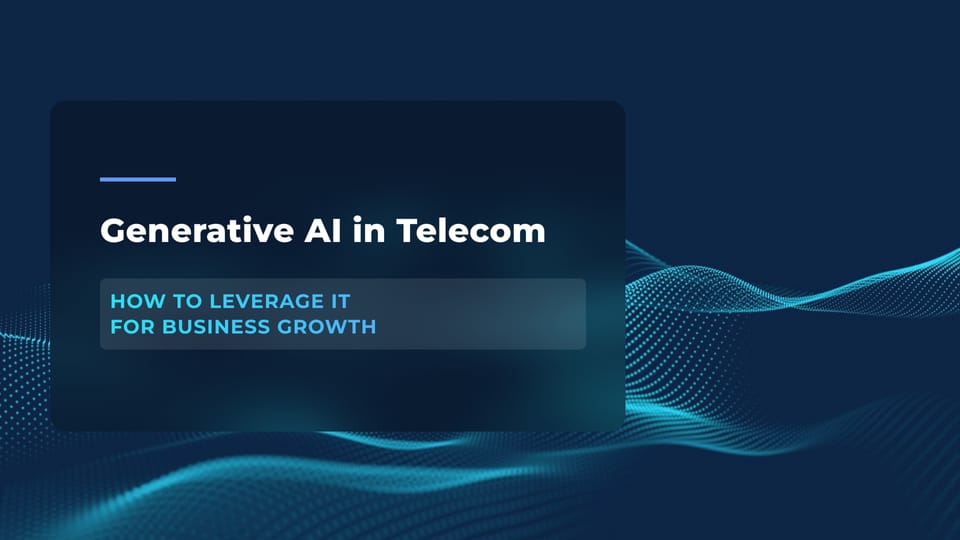
Gen AI is taking the world by storm penetrating all spheres of our daily life and professional activities. It helps businesses reduce costs, streamline operations, increase revenue, and bring many more benefits we can’t list in just one article. But how can communication service providers (CSP) use generative AI in telecom where staying ahead is a constant battle? And can it help telecoms not just to survive but thrive?
The answer is yes. Generative AI has the potential to transform the telecom industry and many companies are already reaping its benefits. Based on the McKinsey report, gen AI helps telecoms cut expenses, especially in customer service and network management. Combined with advanced tech like 5G, IoT roaming, network slicing, and service models like NaaS, generative AI unlocks new revenue streams and boosts income for CSPs. The same McKinsey research predicts the technology could contribute between $60 and $100 billion to the industry.
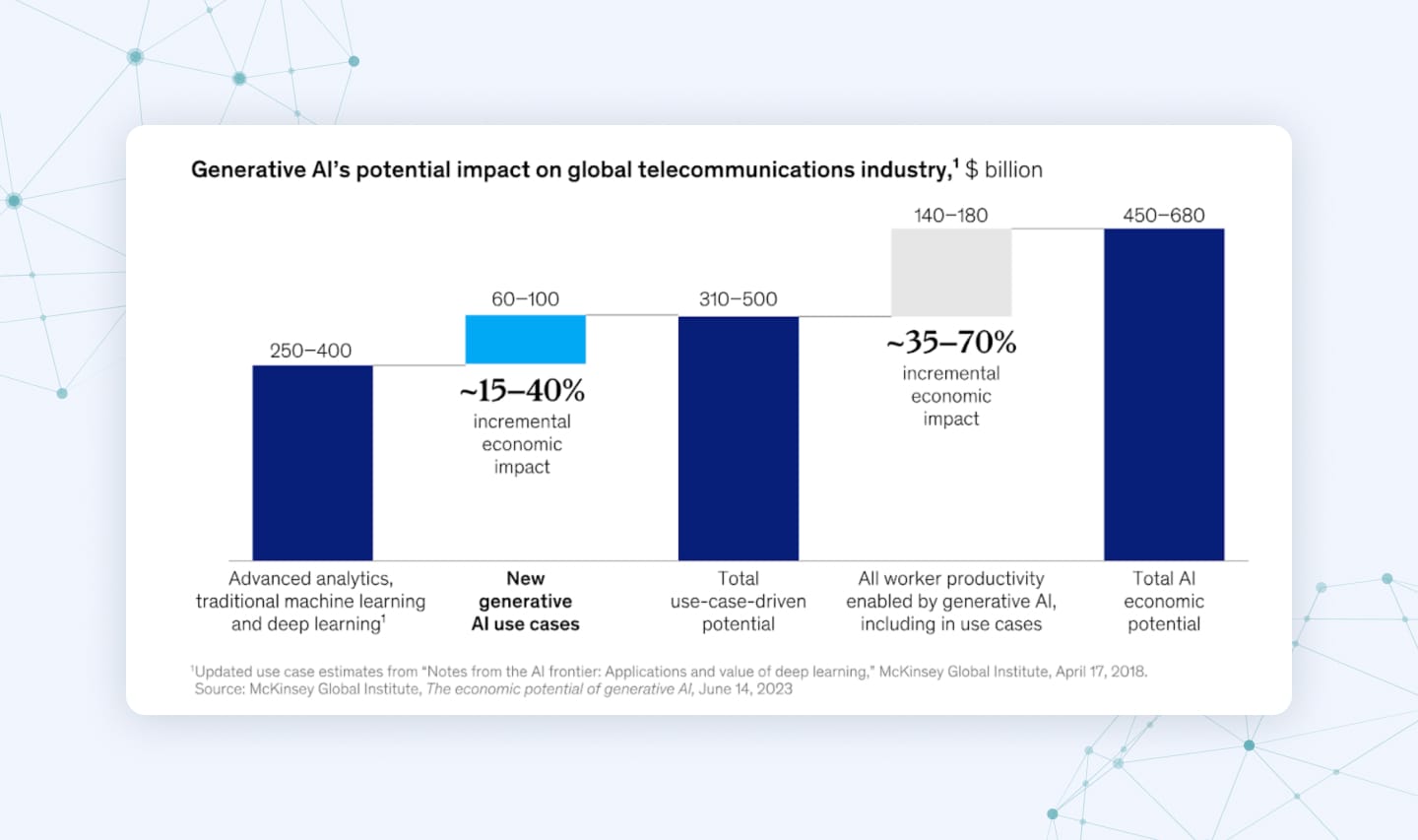
At Flyaps, we’ve been working closely with telcos for more than a decade. Therefore, we’re more than just enthusiasts; we’re committed to uncovering the real potential of generative AI in telecommunications. In this article, we will explore the use of generative AI in telecom industry and see whether it’s the right technology to innovate and grow.
Four gen AI applications adding value to telecom
One of the key benefits for adopting generative AI telecom solutions is the speed of deployment. Unlike traditional AI models, which can take months to implement, pre-trained gen AI models can be up and running in just weeks, so you have all the chances to be faster than competitors.
What’s more, generative AI technology is not something only global mobile network providers can afford. From small startups to international giants, telecom companies of all sizes can use its powerful capabilities without straining their budgets. Further on, we will focus on four key applications where generative AI can greatly help telecom businesses, which are machine-readable content, semantic communications, digital twins, and human-readable content.
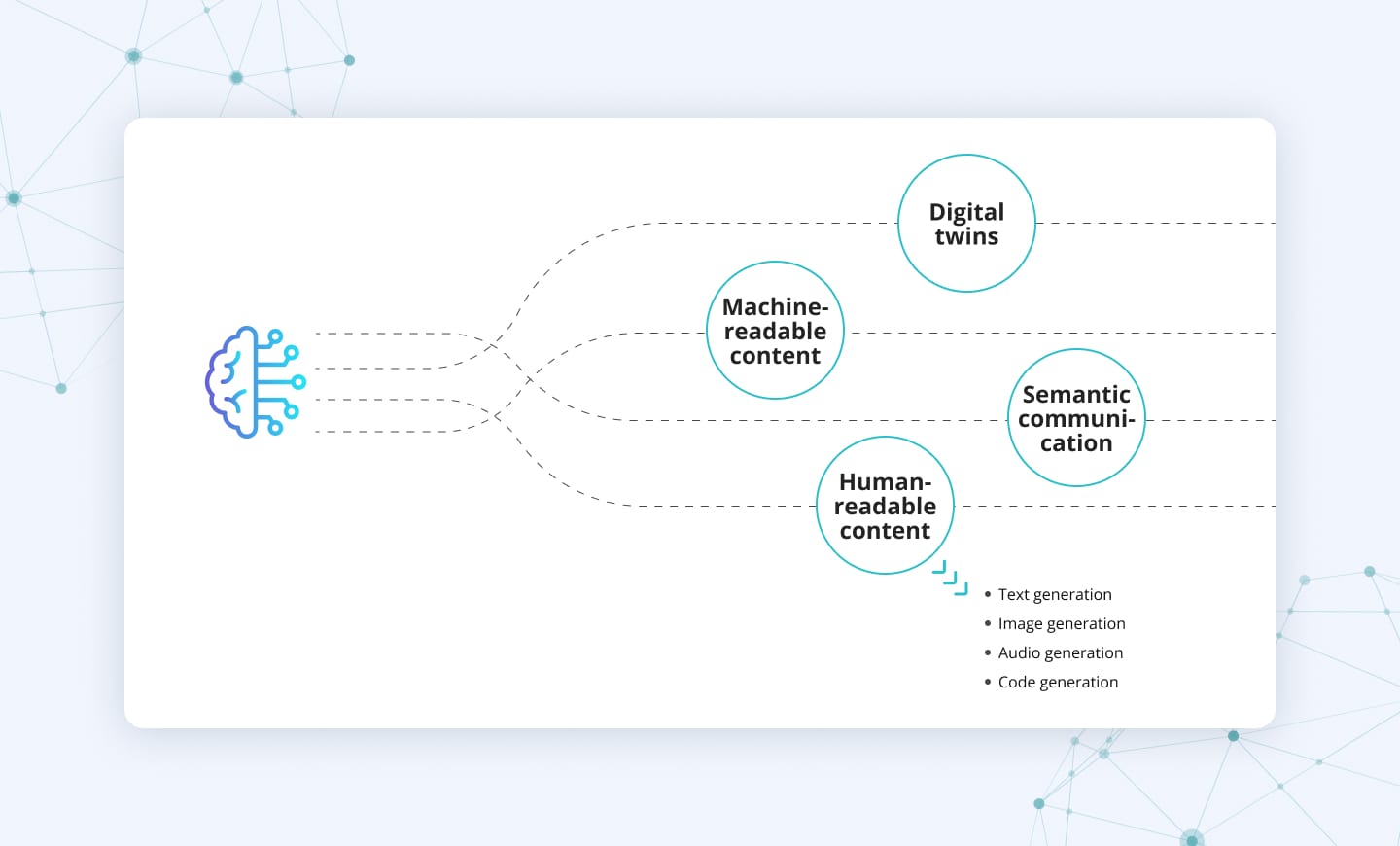
Gaining insights from machine-readable content
Machine-readable content in telecom usually includes customer records, service usage statistics, network performance metrics, device specifications, configuration files, and more. In simple terms, we’re talking about raw data that can be easily analyzed and interpreted by computers without human intervention. Gen AI models can process this data to create valuable outputs like coverage maps, optimize resources, or transform it into human-readable content. It also helps fill data gaps and make networks run more smoothly, especially when data is missing or too expensive to gather.
Saving bandwidth with semantic communication
In plain language, semantic communication is the process of encoding information into a compact, symbolic format that can be then decoded for use after transmission. Gen AI can greatly help at both ends of this process. It can be used to encode raw data for transmission in a way that saves bandwidth, and further decode content. Gen AI-powered semantic communication is useful for mobile networks where space and resources are limited, making communication more efficient.

From cloud migration to telecom-specific AI solutions, we have delivered over 20 projects that are used by hundreds of MNOs and telecom companies worldwide. Check our capabilities and let’s discuss your next solution.
See our servicesCreating digital twins
A digital twin is a virtual representation of a physical object, system, or process that is created using real-time data and simulations. For example, a company creates digital twins of its entire network infrastructure, including base stations, routers, and switches. These digital twins continuously receive data on network traffic, performance metrics, and potential issues. When there is a need to test something new, the company might simulate its impact on the network using digital twins and asses how changes might affect user experience, bandwidth allocation, and overall performance without risk.
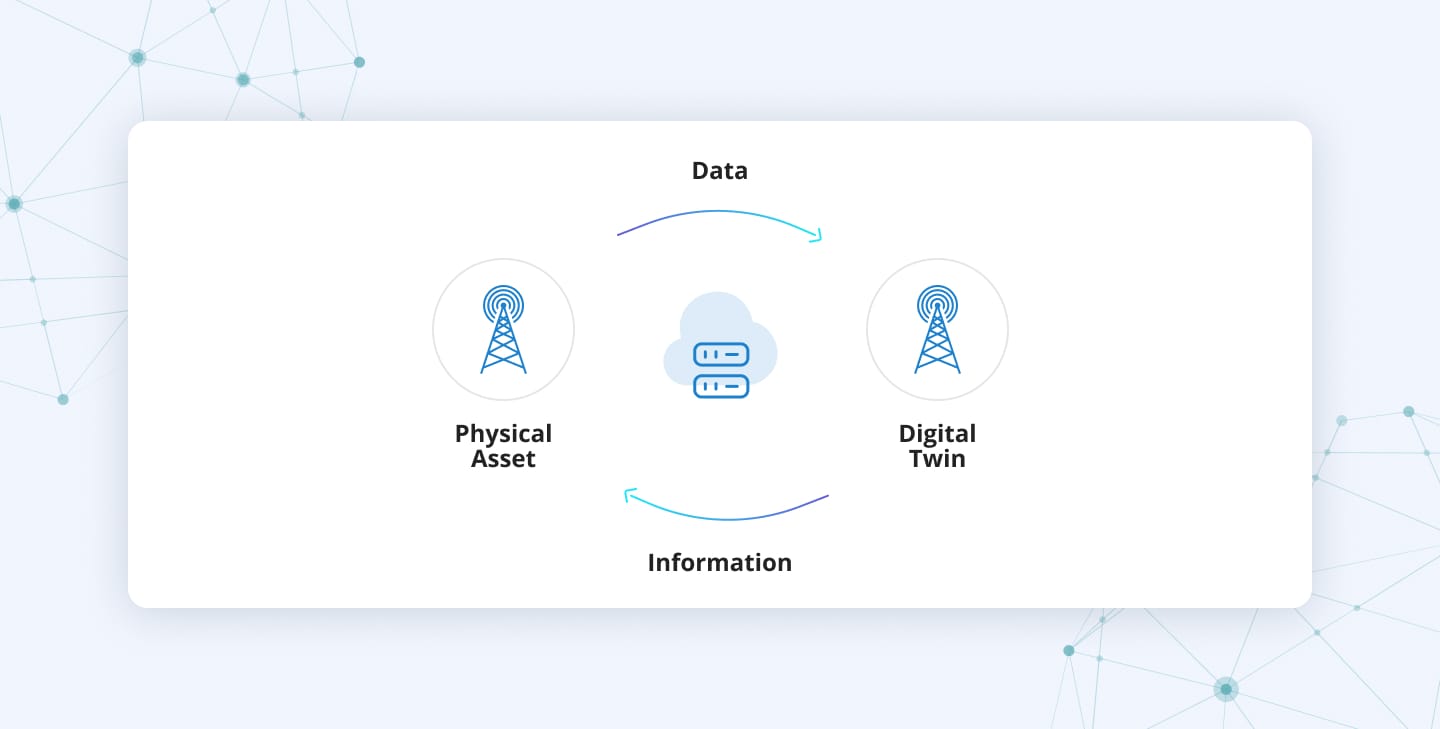
Despite numerous benefits, implementing digital twin technology can be costly, as you need technical expertise and human resources to develop the necessary code. However, generative AI can make this process faster and more cost-effective. Organizations can use gen AI models to create digital twins or train these models to replicate the behavior of physical objects, reducing both time and cost.
Generating human-readable content
From analyzing large data sets to creating product documentation and service level agreements, gen AI can automate content creation in telecom, saving time and reducing workload on teams. It might be also used to build virtual assistants and chatbots, create marketing content, and personalized messaging.
However, there are many more generative AI use cases in telecom industry, so let’s briefly review the most popular ones.
Generative AI use cases in telecom
Gen AI has various applications, including customer service, marketing, network operations, and support. Here is how this technology can transform critical functions in telecommunications.
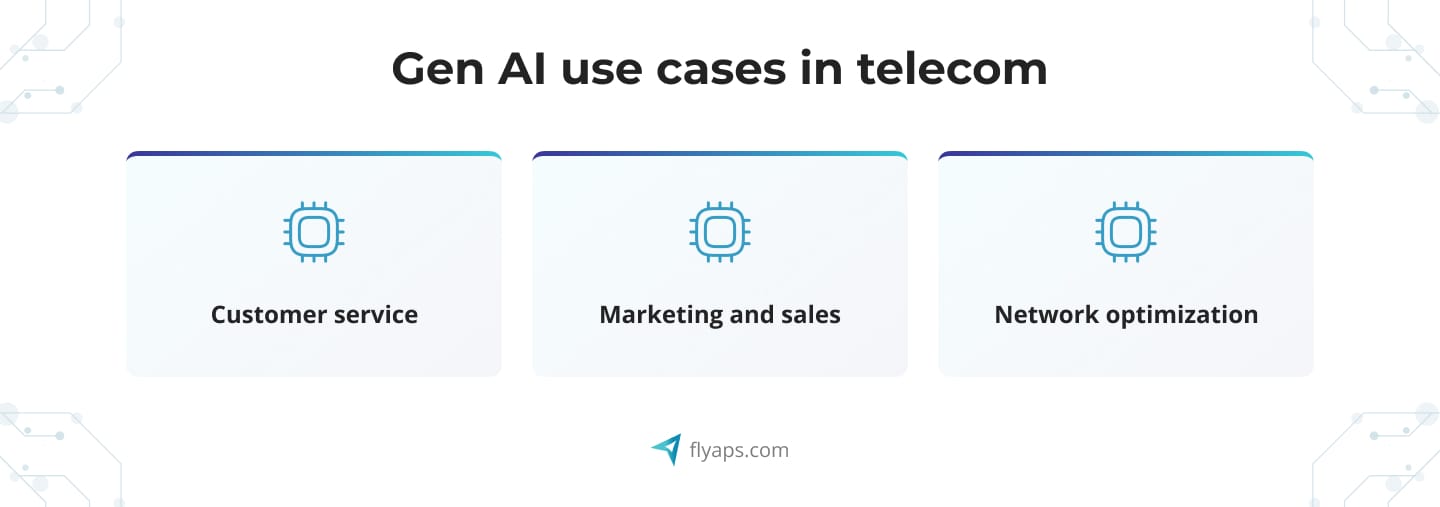
Improving customer service
Before gen AI-powered chatbots, customer service in the telecom industry relied heavily on human agents, who answered phone calls and emails to handle client’s queries. Customers often experienced long wait times and couldn’t use the service during non-working hours. Today, CSPs can address many of these issues with chatbots and virtual assistants which provide instant, 24/7 support. They handle common inquiries and free up human agents to deal with more complex issues.
Besides, gen AI models might be also used to optimize call routing so that customers are quickly connected to the right agents. For example, if a user calls their telecom provider with an internet issue, the generative AI system can analyze complex network data within the query in real time, identify it as a technical problem, and route the call to a technical support specialist.
Today, chatbots and virtual assistants are no wonder to anyone as almost all telecommunication providers already use them in customer service. You’ve probably heard about TOBI by Vodafone or Telefonica’s Aura. However, T-Mobile went even further.

The company partnered with Open AI to build IntentCX, an intent-driven AI-decisioning platform. Planned to go live in 2025, the solution will not only interact with customers but also proactively address their needs, making recommendations and even executing changes or purchases with customer permission. Mike Sievert, CEO of T-Mobile, claims that IntentCX might reduce customer interactions with human support by 75% by 2027, while the final goal is to turn T-Mobile into a “deeply data-informed, AI-enabled digital-first company.”
Streamlining marketing and sales
By analyzing trends, user preferences, and relevant data, generative AI in telecom market can aid in crafting compelling and personalized content. It helps achieve more effective communication with clients and engage specific customer segments.

Vodafone is one of telcos using generative AI for analyzing anonymized transcripts of customer calls to create more accurate and insightful summaries of these interactions, a task traditionally performed by contact center agents. This is achieved using what Vodafone’s CEO, Scott Petty, refers to as a “summarization engine,” a software-driven solution that replaces the manual process of selecting predefined boxes to categorize customer issues.
By applying this technology, Vodafone aims to improve content personalization by better understanding customer concerns and interactions. The AI-driven summarization engine analyzes conversation data to provide more accurate insights, allowing Vodafone to craft content and responses tailored to individual customer needs. This not only leads to more effective communication but also enhances user satisfaction.
Besides, AI-driven insights can also help identify new sales leads and improve conversion rates. For instance, generative AI can analyze customer feedback from various sources, like social media, surveys, and reviews, to understand what customers like or dislike about services and craft marketing campaigns that resonate with customer preferences.
Optimizing network performance
Telecom companies can employ generative AI to optimize network performance, predict potential issues, and enhance resource allocation. Let’s imagine a company integrating gen AI into its network operations. By analyzing real-time data like traffic patterns and device performance, an AI-powered system can spot patterns that indicate when equipment might fail. For example, if it detects a spike in data usage in a specific area, it can recommend reallocating resources to prevent congestion.

Network optimization is just one of the many business purposes for which AT&T has introduced Ask AT&T. This tool has democratized AI, making it accessible and applicable across the organization. It’s designed as an intuitive, conversational platform that employees can interact with using natural language.
Ask AT&T autonomously analyzes customer data, identifying fields, merging tables, and crafting the necessary code to extract valuable insights from the extensive data flows within their network.
Implementing generative AI in telecom industry
Of course, there are many more gen AI use cases in telecom, but the examples we’ve discussed clearly demonstrate its impact on the industry. If you are not sure how to start your gen AI journey, here are some tips on how to integrate generative AI in telecom.
How to implement gen AI in telecom Set clear objectives Choose the right model Prepare your data Train your model Implement and monitor your model performance
Set clear objectives
The first thing you have to decide is what you need gen AI for. Don’t try to integrate AI just for the sake of it. Identify the specific problems you want to address or processes you plan to improve, be it customer service, fraud detection, or network optimization.
Choose the right model
When you know where gen AI capabilities can bring the most value, consider whether you want to build your model from scratch or fine-tune an existing one with your internal data. Of course, the choice depends on your specific use case, but developing a gen AI model from scratch is time-consuming and costly. To do that effectively, you’ll need the right AI development platform that supports large language model customization, deployment, and monitoring at scale. Why waste time and resources when there are many ready-made models, like GPT-3.5, that you can quickly train and deploy?
Read also:

Prepare your data
Next, you should collect and clean relevant data to train your generative AI model. It means removing duplicates, filling in missing values, and ensuring consistency across data formats. For example, let’s say a telecom company builds a chatbot that provides billing information to clients. For this use case, they need billing data. However, this billing data might be recorded in different currencies across regions — one system might use USD, another EUR, and other local currencies. This inconsistency might reduce model accuracy and lead to errors in financial analysis, so all billing amounts should be converted to a single currency, and only then used for model training.
Read also:
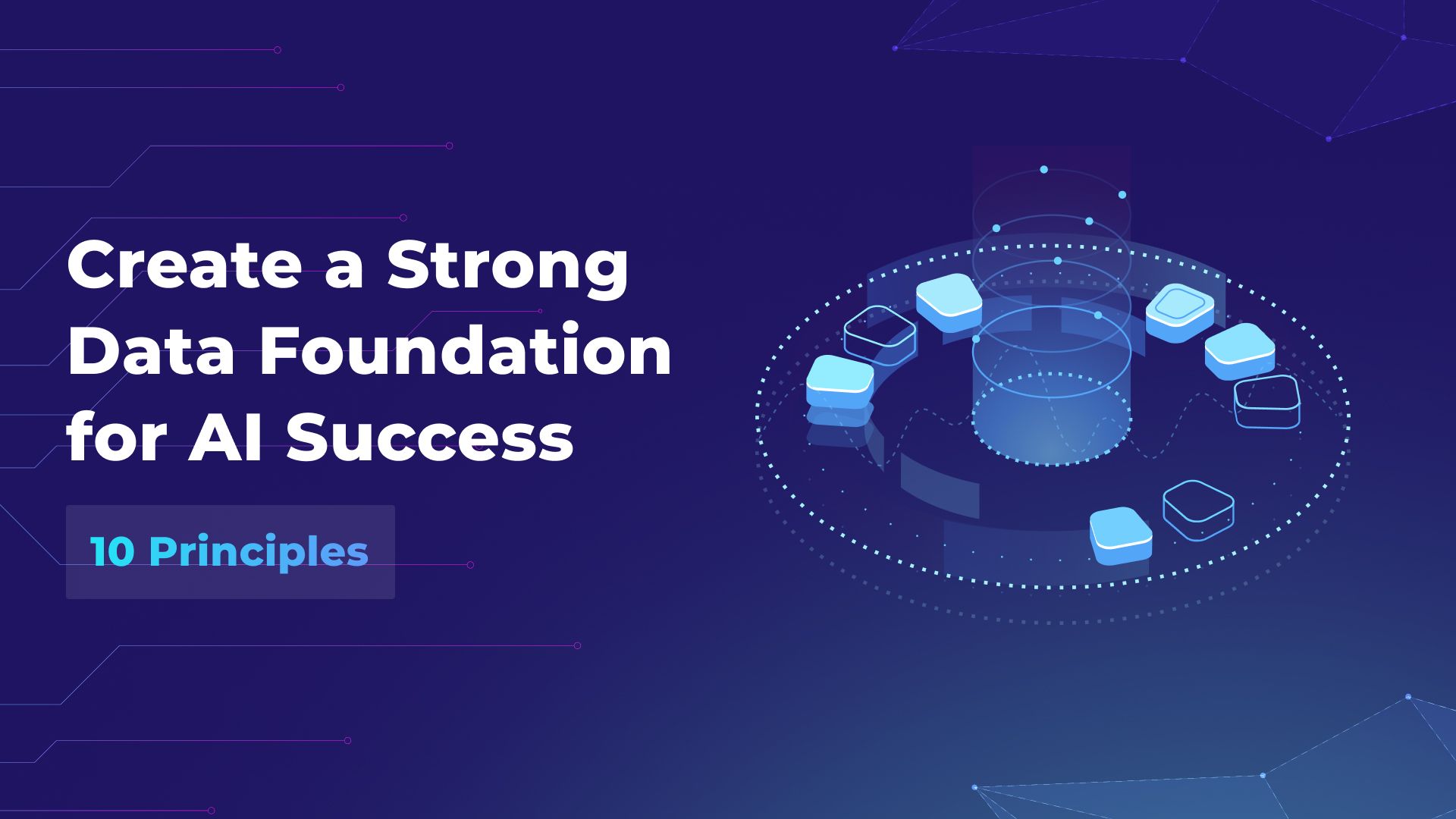
Train your model
Whether building or fine-tuning generative AI models, you should train your model of choice on the curated dataset. Monitor the training process and make adjustments as necessary. This step may involve experimenting with different algorithms, hyperparameters, and evaluation metrics to optimize performance.
Of course, it’s just a small part of a large whole, as model training is a complex and time-consuming process, so make sure you have an expert AI development team in place. At Flyaps, we have extensive experience developing AI solutions and can help you seamlessly integrate AI into your business.
Implement and monitor your model performance
Once the model is trained, integrate it into your existing systems and processes. Set up monitoring mechanisms to evaluate its performance and effectiveness over time. Collect feedback and performance data regularly to refine and improve the model, ensuring it adapts to your changing business needs.
Following these steps will help you successfully integrate generative AI into your organization. But it would be difficult to cope with these tasks without a professional team, and Flyaps is here to assist you every step of the way.
How Flyaps can help you adopt gen AI in telecom
With years of experience behind our backs, we at Flyaps have witnessed the telecom industry’s incredible transformations and have helped companies embrace these changes. We understand the nuances, the challenges, and the aspirations of telcos like no other. This experience is our foundation, upon which we build solutions that perfectly align with the industry’s needs. Let’s delve into how we can leverage our expertise to propel your telecom business into the new, generative era of AI.
Custom development of generative AI-powered solutions
Given that generative AI in telecom is a cutting-edge technology, it requires a deep understanding of the nuances of AI in various applications. Our extensive experience, built over years of working with companies like Netspark IP, enables us to create solutions that perfectly align with your company’s objectives and existing infrastructure.
Seamless integration with your current systems
Generative AI for telecom is not a standalone solution, and it needs to be carefully integrated into your existing systems and processes. Our team is adept at ensuring seamless integration, enabling generative AI applications to harmoniously operate alongside legacy systems and other software tools utilized by your telecommunications company.
Still unsure about whether generative AI is the right fit for your business? Let’s discuss it. Contact us today, and we’ll steer you in the right direction.
Skip the endless hiring cycles. Scale your team fast with AI/ML specialists who delivered for Indeed, Orange, and Rakuten.
Scale your teamFrequently asked questions
Here are some of the most common questions related to the use of generative AI in the telecommunications industry.
Why should businesses implement generative in AI telecom?
Generative AI brings significant benefits to the telecom sector, much like it does in other ones. It helps improve customer experience, reduce costs, enhance operational efficiency, improve network security, and, as a result, help businesses oost revenue.
Can CSPs effectively monetize 5G without using generative AI in telecom industry?
Network operators can’t fully capitalize on 5G without powerful AI capabilities. 5G is a modern technology that requires real-time network visibility, advanced analytics, automated operations, and enhanced security, all of which became possible only thanks to artificial intelligence. Without AI, CSPs can’t effectively manage the complexity of 5G networks, leading to low customer satisfaction rates and lost revenue.
What are some common generative AI use cases in telecom industry?
One of the most popular generative AI use cases in telecom is related to customer support. AI-powered chatbots and virtual assistants are revolutionizing customer service in this regard, handling customer inquiries, troubleshooting issues, and providing support 24/7. Among others, we can also name network optimization, predictive analytics and maintenance, fraud detection, content generation, service quality monitoring, and more.
What challenges might network operators face adopting gen AI in telecom?
Along with numerous benefits, generative AI brings serious challenges for network operators. First off, CSPs should implement robust security measures to keep their customer data safe while interacting with gen AI-powered solutions. Besides, many telecom operators still rely on legacy systems that may not easily integrate with advanced AI technologies. The talent shortage is another significant hurdle, as finding and retaining talent capable of developing AI solutions and handling generative AI algorithms is not easy. Finally, network operators must also navigate regulatory compliance and ensure the quality of data used for AI apps.





